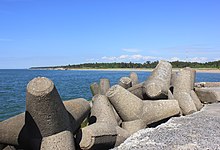Wave-dissipating concrete block
 From Wikipedia the free encyclopedia
From Wikipedia the free encyclopedia


A wave-dissipating concrete block is a naturally or manually interlocking concrete structure designed and employed to minimize the effects of wave action upon shores and shoreline structures, such as quays and jetties.
One of the earliest designs is the Tetrapod, invented in 1950. Other proprietary designs include the Modified Cube (United States, 1959), the Stabit (United Kingdom, 1961), the Akmon (The Netherlands, 1962), the Dolos (South Africa, 1963), the Stabilopod (Romania, 1969),[1] the Seabee (Australia, 1978), the Accropode (France, 1981), the Hollow Cube (Germany, 1991), the A-jack (United States, 1998), the Xbloc (The Netherlands, 2001) and KOLOS (India, 2010) among others.
See also[edit]
- Artificial reef – Human-made underwater structure that functions as a reef
- Breakwater (structure) – Coastal defense structure
- Coastal management – Preventing flooding and erosion of shorelines
- Coastal erosion – Displacement of land along the coastline
- Ocean surface wave – Surface waves generated by wind on open water
- Riprap – Rock or concrete protective armour
- Seawall – Form of coastal defence
References[edit]
- ^ Spătaru, A (1990). "Breakwaters for the Protection of Romanian Beaches". Coastal Engineering. 14 (2). Elsevier Science Publishers: 129–146. doi:10.1016/0378-3839(90)90014-N.